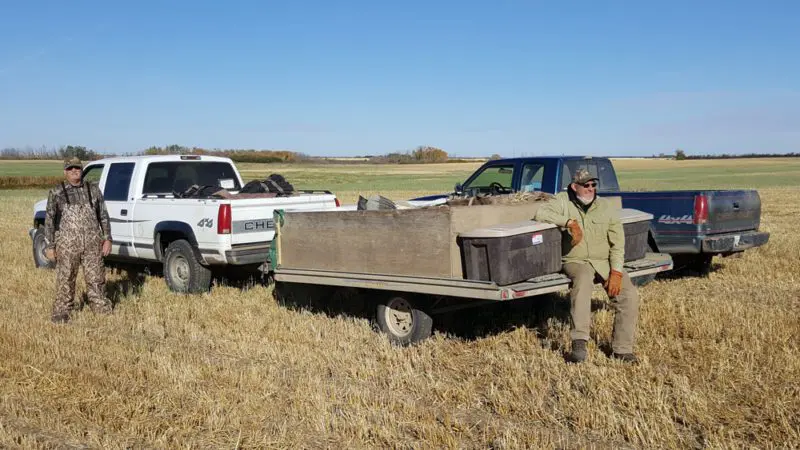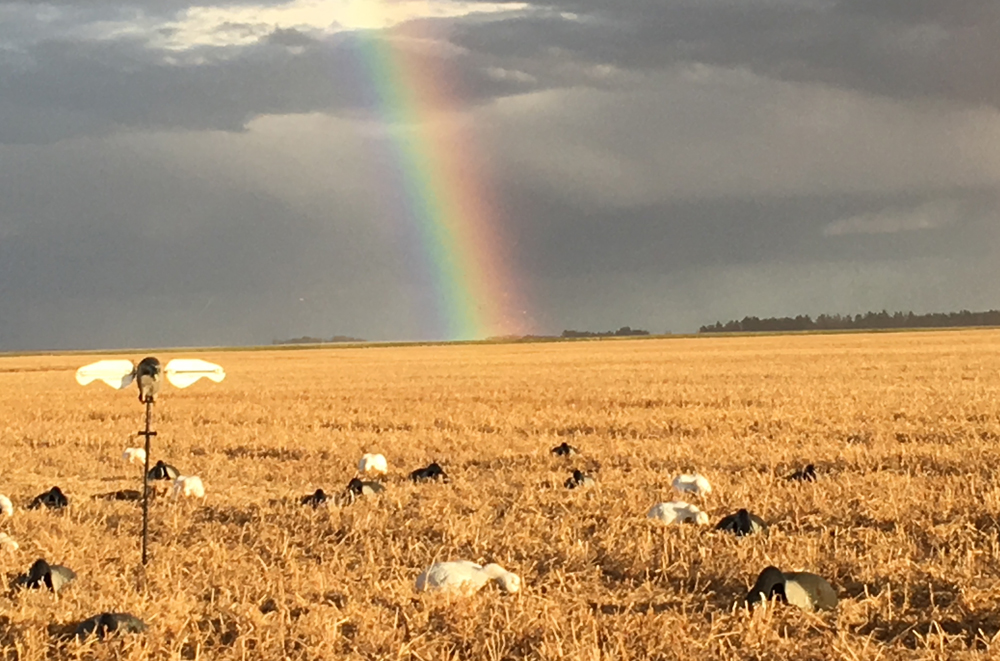A pot of gold at the end of the rainbow. The legend says that the faerie gold will fade away. But on the prairie the gold is grain—barley, corn, wheat, oats, peas—and after it is harvested the waterfowl fly into the fields to eat the gold the machines left behind. Those waterfowl are my pot of gold, and at the end of what seems to be a short five-day hunt, they, too, fade away. Until next year.
I live in northern New Hampshire, where the waterfowling opportunities are limited. When I am at the end of my rainbow in Saskatchewan, however, I hunt mallards, pintails, blue- and green-winged teal, Canada geese—both greater and lesser—cacklers, greater and lesser snow geese, Ross’s geese, specklebellies, and sandhill Cranes. Watching those beautiful birds, especially the ones I cannot hunt in New Hampshire, fly over our decoys makes the two-day trip worthwhile. Sometimes I do hit a bird, and specks and cranes eat better than anything I have shot in New England.
This afternoon we’re hunting snow geese and prospecting for duck. The duck have not been flying in the afternoon. The nights have been clear with a bright half moon, and I think that they are feeding by moonlight. “Romantic” for them, but frustrating for us hunters. Snows, on the other hand, have been decoying in the late afternoons, so we set up a rig of 200 decoys—snow geese with two robo-ducks and 20 Canada geese dekes. We’ve found that the combination of a few Canada decoys and robo-ducks work well on mallards and pintails.
We touch up our layout blinds; camo is everything when you are trying to decoy snows. They’re spooky birds and give spreads a very long and distant look before coming near. We pull up plants to the roots, shake off the dirt, and try to make our blinds disappear. We place silhouette decoys around our four blinds so that their shadows break up the shape of the layouts. Then we drink water—lots of hydration needed on the prairie—settle back into our blinds, and wait. Frank and George practice coming up to shoot: a fast sit-up with your body pushing the doors of the blind open as you mount your gun. I do a few sit-ups, too, and bring my gun up to where the birds should be. We’re ready.

Frank, left, and the author rest after a morning of decoy-placing and waterfowl-dropping.
But instead of birds we hear thunder and see very dark clouds in the distance. Colin checks the weather on his phone. It’s good news; the storm is going to go around us. It is a spectacular prairie vista: dark clouds with lightning on the left, sun and some wind to the right. It takes an hour for the storm to swing past, and as it passes we see a double rainbow. A few minutes later we hear birds—the high piping of snow geese and the deep grunts of Canadas. We hope for snows; it’s illegal to hunt dark geese in the afternoon.
We watch flocks of specks and Canadas fly low overhead. They outline themselves against both the dark, distant storm clouds and the clear blue sky overhead. The snows are way up, seemingly “mile high.” The darks are in range and illegal; the whites are legal and well out of range. We laugh and shrug and wait, hoping that our chance will come. Jokes, water, and Snickers bars. We know the snows will eat soon. We’ve set the table; come and dine with us.
Finally, Colin says, “Boys, we have whites on the right, low and heading for us.”
We freeze under the blind doors and behind our eye-screens. No one moves a muscle. Colin is our eyes, but we have ears, and we hear high-pitched yips in the distance coming our way. My shooting hand shakes from eagerness and excitement as I hear the barks come closer. And closer.
“They’re on the right, low and on a line for us,” Colin says. “Get ready.”
Get ready?! I’ve been ready and trembling from eagerness for minutes now. Come on, geese; come on. Frank is on the right; George is in the middle; I’m on the left. Colin is behind us in the “observation booth”; he’ll call the shot. He’ll wait until some of the geese are past Frank and even with George. I’ll shoot clean-up. Out of the corner of my right eye, through the mesh, I see ten birds with cupped wings. My breathing increases. My hands are shaking. When I stop getting excited, I’ll stop hunting.
“Take ’em!” Colin shouts.
We come up out of our blinds shooting. I fire at the far-left goose, see him fold up, and swing on the next. As I pump my Model 12 and line up on the bird, he falls before I can shoot. That George. Man, he’s fast! I move to another flaring bird, cover him, keep swinging, and fire. He folds. I shoot again at a high bird and miss. On the right I see birds falling—Frank at work with an assist by George.
Nine shots and seven birds down. The birds fell in front of where the rainbow had been. Prairie gold, but this memory won’t fade.

